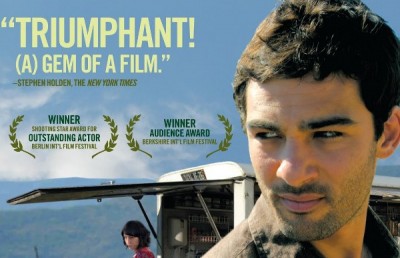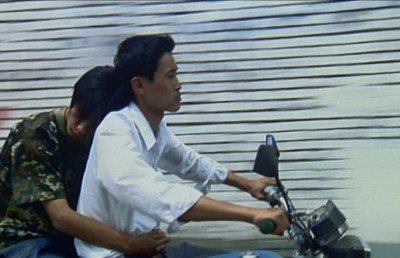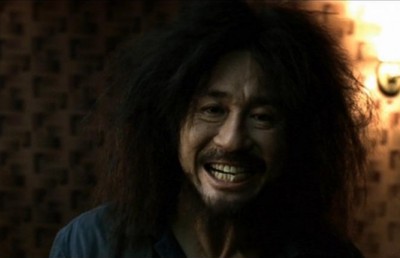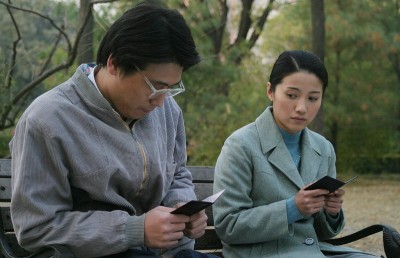My Blueberry Nights: Love Drives Full Circle
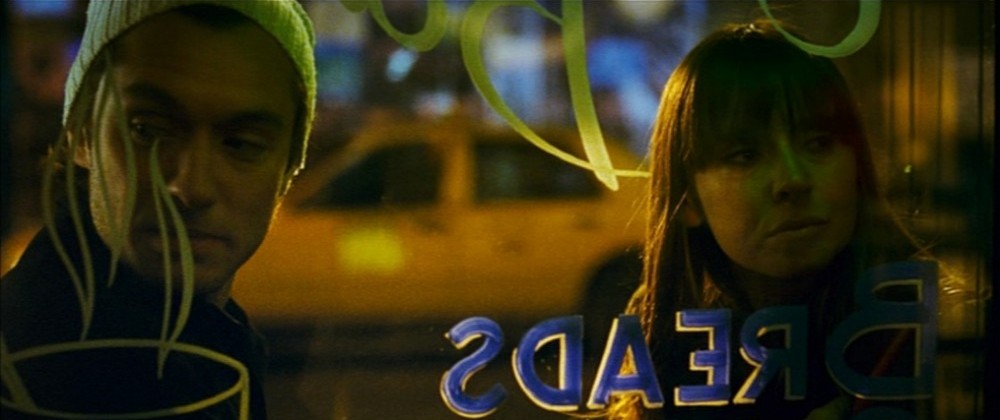
My Blueberry Nights is in many respects Wong Kar-Wai’s Americanized version of his two (better) Hong Kong love poems, or poems of broken love, In the Mood for Love and 2046. It charts much the same thematic territory as the two earlier films: unrequited love, sorrowful love, the transience of life, chance and serendipity (less so in this film), and memory. It also recalls the former films visually by giving the subject a sultry, sensual surface (literally) beauty, with appropriately melancholic music. The main difference is that when it all adds up, My Blueberry Nights, while still a satisfying film, lacks the emotional depth accorded to these themes by the earlier two film. In other respects it recalls some of Wong Kar-Wai’s other films in its treatment of urban isolation: Chungking Express (1994), Fallen Angels (1995), and Happy Together (1997).
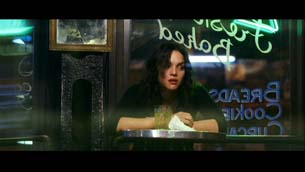
In keeping with what is more of an American tradition, My Blueberry Nights is a road movie, but one that moves in spurts. In the film’s press kit Kar-Wai states: “I wanted to see how certain themes would translate in a different culture and landscape…2046 was about time, My Blueberry Nights is about distance.” This difference is seen in the title cards introducing each new geographical move, with the amount of days included alongside the distance in kilometers (or miles for the US version). The lead character, Elizabeth, played by the beautiful Norah Jones in her first acting role, is one of the most passive leading characters in all of recent cinema. She travels and does nothing much more than look, watch, observe, and listen. She becomes a cipher taking in all the big emotions she sees around her. Even the eventual ‘climax’ –the long awaited kiss from the NY café owner she befriends, Jeremy (Jude Law)– she receives while asleep, her head on the counter. In comparison, in In the Mood for Love the expected kiss never does come, or at least we never see it arrive, hence the physical connection remains a mystery, while it is consummated here. Elizabeth is a jilted lover (we see her lover only once from the ground floor as she looks up through their corner flat window and sees him with a new lover, an image that can be mistaken for an Edward Hopper painting). She strikes an immediate bond in the film’s opening scenes with Jude Law, a Mancunian living in NY running an all-night diner. He too, as are all the characters of consequence we will soon meet in the film, is a loner: along with Elizabeth and Jeremy, there is police officer Arnie (David Strathairn) and his estranged wife Sue Lynne (Rachel Weisz) in the Memphis section, and gambler Leslie (Natalie Portman) in the Nevada (Reno, Las Vegas) section. They are all linked by emotional loss: Law is still wincing over the loss of his lover Kayta (played by indie pop star Chan Marshall of the band Cat Power, who play two songs in the film), who returns to say goodbye to him at the end before leaving for good; Arnie is a self-absorbed cop who has not come to terms with a marital break-up with Sue Lynne (Rachel Weisz), a rebellious wildcat who has replaced an oppressive marriage with a series of one night stands with young cowboys; and Leslie, a young, reckless gambler who is estranged from her rich father. When she gets a call from a Las Vegas hospital informing her that her father is fatally ill, she thinks it is a prank to get her to return home. She delays returning and arrives moments after he has died in the hospital. Elizabeth is a witness at all of these events, soaking them in from the sidelines and using them to help heal her own pain.
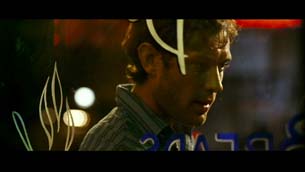
After a restless few nights with Jeremy lounging at his all-night café, drowning their sorrows in blueberry pie and lemon meringue, Elizabeth leaves the city to escape her pain and attempt to recharge her emotional batteries. Her first stop is Memphis, where she works two jobs, as a waitress named Beth at a diner and as Lizzie, bartender at the bar where Arnie slowly drinks himself drunk each night, the Memphis Bar & Grill. Wong’s agonizingly slow motion shots of Arnie teetering at his stool, face about to plop onto the counter, are at once funny and sad. The pain is so deeply etched in Strathairn’s face in follow-up close-ups that it pains us to watch him self-destruct. He lashes out at his wife’s current boyfriend, beating him up in the bar, and lashes out at his wife when she later enters the bar, to the point where he threatens her at gun point. The next time we see him in the follow-up scene he is dead, wrapped up around his steering wheel in the aftermath of a car crash. Was the accident a death wish, a suicide or was he just too drunk to drive? In the end it doesn’t matter.
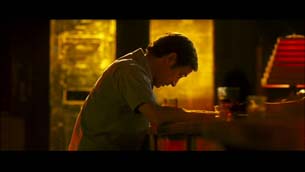
Wong Kar-Wai however, continues to care about Arnie even when dead. As Sue Lynne wonders, “How will people remember Arnie?” The bar he frequented has a memorial in the bar’s storefront which the camera reveals briefly in one of its many lateral movements. Elizabeth also wonders as she writes in a letter to Jeremy, how will you remember me, as the woman who ate blueberry pies or the jilted lover? Hence memory remains an important element to Wong Kar-Wai. Elizabeth learns that people do have the ability to change or perform minor acts of redemption. Right after the death of Arnie, Sue Lynne seems to continue his cycle of self-destruction by drinking at his usual spot at the bar, but goes into a frenzy when asked by the bar’s owner Travis to pick up her late ex-husband’s bar tab.
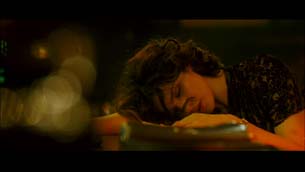
However, once sober Sue Lynne pays his posthumous $800.00 debt before riding out of town herself. Elizabeth’s next stop is Ely, Nevada, where she works as a waitress at a casino. She befriends Leslie (Portman), who is forever immersed in high stakes poker games. After a big loss leaves her penniless Leslie strikes a conversation with Elizabeth, who is outside the casino eating a sandwich. She learns that Elizabeth has been saving up to buy a car. Leslie makes a proposition to Elizabeth: loan her all of her savings, $2200.00, which she will promise to pay back in full plus one-third of her winnings. If she loses she will hand over the keys to her new Jaguar. Elizabeth accepts. The scene coyly cuts away from the poker game before the revelation of Leslie’s fate at the end of a high stakes, winner take all hand. We cut to Leslie exiting the casino looking disturbed. She tells Elizabeth that she lost, but that there is a man in Vegas who will front her the money, so they take to the road. Between Nevada and Vegas Elizabeth learns that the man in question is Leslie’s father, who she has been informed has been admitted into a hospital. Suspecting emotional trickery, Leslie delays her arrival at the hospital, only to learn that the illness was real and her father has passed away. More revelations follow: Leslie can not give the Jaguar to Elizabeth as promised because it was a reluctant ‘gift’ from her father (she stole it but her father mailed her the registration and ownership papers); but she also lied about losing the poker game (she lied to ensure that she have someone to drive with to Las Vegas). She gives Elizabeth her money back, plus enough of a share of her winnings to buy a used car. They take to the highway together and then split at a fork in the road to go their own way.
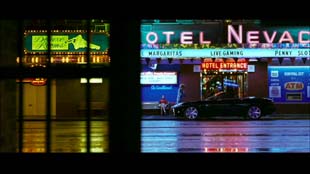
The film ends where it began, 300 days later, full circle, with Elizabeth back at the café with Jeremy, who is ecstatic to see her back. What has she learnt about herself from her visits to Memphis, Ely, Nevada, and (briefly) Las Vegas? At the simplest level she has come to an understanding about emotional pain, and that, as personal as it may seem, is actually universal. As stated earlier, each character she meets has or will soon experience the emotional pain of loss. When Elizabeth returns to New York she stands under her empty apartment, with a “For Rent” sign hanging in the window, and slowly manages a smile; a smile of acceptance and acknowledgement that her life must go on. This is followed by her calling back at the diner to collect her slumbering kiss. Because Elizabeth remains fairly passive throughout her encounters the film lacks the sort of powerful emotional burst that would render the sense of a true emotional rebirth (like with Sue Lynne). Her travels have also taught her to trust people, even those who lie at first. Perhaps she has learned from Leslie, who herself followed the advice of her father who said, “Trust everyone…but always cut the cards.” Or she has simply learned to trust her own gut feelings, which were to return home and believe that she can have a meaningful relationship with Jeremy.
The loneliness that all the substantial characters feel in My Blueberry Nights is represented in the fact that none of the characters have any meaningful communication with anyone. Jeremy talks on the phone with people, but never with people in his café, any more than ‘good night.’ Arnie is drunk most of the time and only has meaningful talk with Elizabeth; and Leslie talks the usual male posturing talk during the poker games, but only engages in human discourse with Elizabeth. Even when she gets to her father he is dead and hence she can not do anything more than cry.
Visually the film begins at a quick pace, with the opening scene at the bar continually cutting back and forth between the two characters. As throughout, the camera moves laterally and captures characters through objects in the foreground, through storefront windows which have garishly colored titles on them, or in reflections. The film’s color scheme (which remains pure Edward Hopper in the context of American art) is at least reflective of Kar-Wai’s earlier films: saturated colors, bleeding neon lights, objects that stick out in the frame because of their hot color temperature. Everything is treated sensually: the suppressed physical attraction between beautiful people (and Law and Jones are that) is sublimated onto the languid (mainly lateral) tracking shots, the slow motion imagery, and the step-printing visual effects (the latter perhaps the single most identifiable Wong Kar-Wai stylistic trait), the torch music, the telephoto aesthetics which produces a shallow focus that carves out character faces from the background like sculptures, and, the colors (lots of blues, reds, browns). Like in earlier Kar-Wai films, the sensual use of music (original music by Ry Cooder, songs sung by Cassandra Wilson, Norah Jones, and Chan Marshall) plays an important role in establishing the film’s mood and rhythm. To begin, there is the appearance of two music stars in the film. When Norah Jones was asked to work on the film she thought Kar-Wai wanted to use her music in the film: “I thought maybe he wanted music….And he asked if I wanted to act!” [1]. Chan Marshall (known as the indie pop songstress Cat Power) was chosen primarily for her music, but Kar-Wai decided to cast her in the small but important role of Jeremy’s former lover. Kar-Wai also used her music as an important presence on the set: “During the shoot, I was constantly playing her music for inspiration….Eventually I decided to include two of her songs in the film and then, finally, I decided to include her in the film.” [2] Even the Iranian born/Paris educated cinematographer Darius Khondji (Se7en, Stealing Beauty, Panic Room, The Ruins, Zidane: A 21st Century Portrait, Funny Games) used the on-set music to help establish his camera movement rhythms: “The best way for the camera to pick up rhythm is music….I felt all the time with him, like I was playing with a rock band around the United States. We followed him around and played with him as well as we could.” [2] Other than Kar-Wai’s own films, the cinematographic style on display –the shallow focus, soft focus, use of objects in foreground, saturated colors, etc.– recalls Dion Beebe’s cinematography in Jane Campion’s In the Cut (2003).
The film’s structure is cyclical, ending where it began, but it also hints at cycles of pain. For example, right after Arnie dies his wife Sue Lynne appears and sits in the exact same spot at the bar where Arnie sat, and has her first drink in six years. While a song plays from the juke box, diegetic lyrics repeat the symbolic line ‘do not make the same mistake again’. The cycle repeats again at the end with the close-up of Elizabeth’s face and her ice cream smudged lips. This is the same image we saw in the opening, when she fell asleep at the café on the first night. On the first occasion of this image her face darkens when Jeremy’s face comes down to block the light and cast a shadow over her face. The camera cuts back to her lips to find them clean of any ice cream. We wonder: how did the lips get clean? We get the answer after she returns and eats pie and ice cream again and we are treated to another extreme close-up of the pie and melting ice cream, which now gains even more symbolic sexual meaning the second time. The scene cuts to an overhead two-shot of the sleeping Elizabeth and Jeremy resting his head across from hers.

He begins to kiss her, licking the ice cream off her lips. The film ends on this image of love and hope. A sense of cyclical time appears in the film also through many ‘doublings’ that occur throughout the film. For example, the fight scene in Jeremy’s bar in the New York section is echoed by the fight in the Memphis bar, when Arnie attacks Sue Lynne’s latest lover. Even with the ‘doublings’, the film is linear but for one brief moment near the end, after Elizabeth returns to Jeremy’s café. The image of the door ajar and a hand on the doorknob triggers a memory of the night she left, and she tells Jeremy that she almost returned to the bar that night, and then we see a close-up of (we assume) her hand on the doorknob on that fateful night, opening and closing the door.
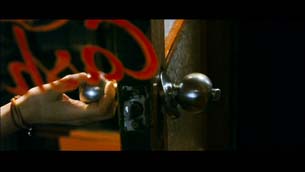
Although the film’s pace slackens after the opening quickly cut scenes, there is only one noticeable instance of a long take, an impressive single take which showcases Weisz’s acting: after the huge bust up/confrontation between Sue Lynne and Arnie, where she publicly tells him that it is over between them and that he means nothing to her, she leaves the bar after being threatened at gunpoint by Arnie, who doesn’t have the heart to go through with his threat. The bar’s owner Travis (Frankie Faison) asks Elizabeth to follow Sue Lynne to make sure she gets home safely. Elizabeth and Sue Lynne sit at the edge of a sidewalk under the city’s neon nightlights, with the camera parked in profile, with Weisz in focus and Jones in the background to her left in soft focus. Sue Lynne pours her heart to Elizabeth in a medium close-up two-shot, telling her how she met Arnie as a 17 year old and how they fell in love, then tried to keep their love alive by drinking; how he loved her too much, suffocating her with his overbearing emotional demands. She admits that she did not hate him but just wanted him to let go of her, something he was incapable of doing. In the end, she admits that as much as she loathed his oppressiveness, now that he is gone she misses him. The long stretch of dialogue (monologue really, since Elizabeth speaks but a few words) is handled in a continuous shot of nearly four minutes (DVD time code: 44’22”-48’10”).
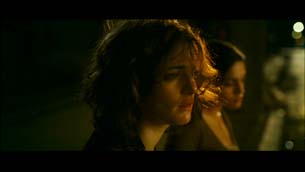
It should be obvious, but Norah Jones is the weak point in terms of the acting performances, and she is not really able to give her character the weight that is necessary, and that Weisz and Strathrain are able to give to their characters. That the film lacks any real emotional or thematic weight is evident in the way Kar-Wai and co-screenwriter Lawrence Block fill the film with weighty metaphors: the bowl full of keys left behind by jilted lovers, which Jeremy keeps so that the ‘door can be opened’ (i.e. in case a lover returns to claim them), until the end, when he throws the keys away. The sensuous close-ups of the pie/ice cream that sublimate the sexual attraction between Jeremy and Elizabeth; Leslie’s father’s poker-styled advice to “Trust everyone but always cut the cards,” Elizabeth’s bit about “walking across the street,” which she does at the end. (Saying something to the effect of, “It wasn’t so hard to cross that street after all. It all depends on who is waiting for you on the other side.”) The blueberry pie that no one buys but which bears no judgment on the pie but reflects chance and choice, etc. In the end, Wong Kar-Wai fans may feel that My Blueberry Nights is inferior to his earlier films, or that he is treading water, but one thing that can not be said of him is that he is using this as a calling card for Hollywood, or that he has diluted his style for more mainstream appeal. The latter is clearly not the case, and I would add that, as far as romantic films go, this is still head and shoulders above the usual American romantic film being released these days (frankly, not that I see many of them!).
The Memphis section provides the film’s best moments. The section is better for two reasons. For starters, the coupling of actors David Straithrain (Arnie) and Rachel Weisz (Sue Lynne) is far better from a strictly acting standpoint than the couplings in the two others sections: Jude Law (Jeremy) and Norah Jones (Elizabeth) in the New York section and Natalie Portman (Leslie) and Norah Jones in the Nevada/Las Vegas section. A second reason that this section fares better is because both parts of the emotional equation, Straithrain as Arnie and Weisz as Sue Lynne, are better developed characterisations, whereas the ‘causes’ of the emotional pain in the other sections are not. Elizabeth’s lover of five years who is having an affair with another woman is seen fleetingly from afar through an apartment window in one scene; the woman who broke Jeremy’s heart – “a Russian girl who loved collecting keys and watching sunsets”– appears in one brief scene near the end of the film; and Leslie’s estranged father is frequently spoken about but is never seen.
I first saw the film at the theatres, in its 35mm glory, but I can happily say that the transfer presented on The Miriam Collection DVD is an accurate representation of DP Darius Khondji’s vibrant and ‘hot’ color lighting scheme. The welcome transfer does an excellent job of transmitting the film’s sensuous beauty to the smaller screen. The special features are par for the course by offering a standard Making Of Featurette (16 min.) which has brief interviews with all the major performers and Wong Kar-Wai. Far better is an 18 min. on-stage Q & A with Wong Kar-Wai and moderator David Schwartz conducted on April 2008 at the Museum of Modern Art. Filling out the special features roster is theatrical trailer and a photo gallery.
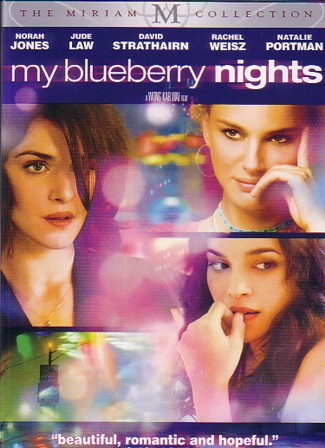
Endnotes
1 My Blueberry Nights Press kit
2 My Blueberry Nights Press kit



